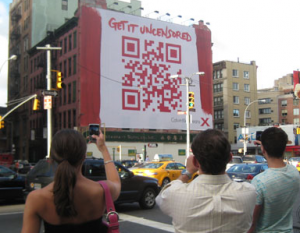
You shouldn’t have to wait for technology to reach critical mass to start using your phone for more than words with friends.
QR codes aren’t dead; their potential is unrealized. There’s no arguing that NFC is a superior technology, but until mobile phones support NFC, there’s no use in stopping people from using QR codes – and I’m not just saying that because I’m employed by a company that uses QR codes.
QR codes are misunderstood, and there’s enough examples of marketers using them incorrectly to back up that theory. A QR code shouldn’t be used as just a shortcut between a print ad and a website. A QR code should enhance an experience, not redirect the user to a promotional website. Anyone who takes the time to scan the code should be rewarded. Encourage your customers to become a part of the experience; don’t just come at them with marketing mumbo jumbo.
Check out these successful QR code campaigns:
- Sales. A great example of engaging consumers with QR codes is Chevy. At SXSW 2010, Chevy placed QR codes on models of the Volt and Cruze. There were a total of 15 QR codes between the two cars, each highlighting a different feature.

- Entertainment. HBO used a QR code to advertise season 3 of True Blood. TV viewers were able to scan a QR code and unlock an exclusive preview of the upcoming season. Even movies like Iron Man 2 and Inception implemented a QR code campaign. The Iron Man 2 code was even cleverly integrated, too, instead of the standard slap on the poster.
- Social Media. Diesel included Facebook-enabled QR codes in their stores. The code would link to their Facebook page, and if you “liked” a specific product, you would be rewarded with a discount.
- Retail. Macy’s initiated a similar campaign, but instead of offering discounts, they gave shoppers access to videos and tips from various designers and creators. Macy’s went one step further by actually educating their customers about the campaign. They uploaded a video to YouTube to explain what the QR code was and what it did.
- Fundraising. Be The One and ScanLife teamed up raise money for the Gulf, during the great BP Spill of 2010. ScanLife created a QR code that, when scanned, would direct users to a site where they would watch the Be the One video and sign the petition.

- Transportation. Tesco/Home Plus created virtual stores in subways in South Korea. Commuters could get their shopping out of the way while they waited for the their train. The groceries will be delivered to their homes.
- Transactions. Starbucks Card Mobile app, although using a different type of 2D barcode, the app lets users pay for their lattes with their smartphone. The cashier simply scans the 2D barcode on their phone and the money is automatically deducted from their account. I’ve tried using the app and it’s significantly faster than paying with cash or plastic.
NFC is still in its infancy, and once manufacturers get on board, consumers and merchants will still have to worry about NFC standardization. In the mean time, why should we wait to take advantage of QR code marketing opportunities? If anything, QR codes are only helping to familiarize consumers with the idea of integrating smartphones with their shopping habits.
QR codes aren’t a dead technology. Maybe it’s just creativity that has gotten stale.








